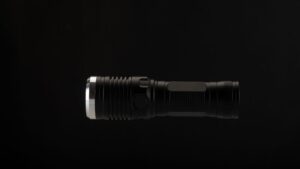If you’ve ever shopped for a high-performance flashlight, a vaping device, or even an e-bike, you’ve likely come across rechargeable batteries with names like “18650” or “21700.”
So, what are 18650 and 21700 batteries? They are the two most popular types of cylindrical lithium-ion (Li-ion) cells powering countless modern electronics. The names are actually a simple code for their physical dimensions:
- A 18650 battery is 18mm in diameter and 65mm in length.
- A 21700 battery is 21mm in diameter and 70mm in length.
This seemingly minor size difference creates a major impact on performance, directly affecting a device’s power, runtime, and overall capability. This guide breaks down the key distinctions to help you understand which battery is the right choice for your needs.
What Are 21700 and 18650 Batteries?
These battery types are lithium-ion cells named after their physical dimensions, with each number representing millimeters of width and height. Both serve as rechargeable power sources in various electronic devices and applications.
Definition of 21700 Batteries
The 21700 battery measures 21mm in diameter and 70mm in length. The final zero indicates its cylindrical shape.
These cells typically provide 4,000-5,000mAh capacity depending on the manufacturer and chemistry. Tesla popularized this format when they adopted it for their Model 3 vehicles.
21700 batteries deliver higher energy density compared to older formats. They can handle discharge rates up to 35A in high-drain applications.
The larger size allows manufacturers to pack more lithium-ion material inside. This results in longer runtime and better thermal management.
Definition of 18650 Batteries
The 18650 battery measures 18mm in diameter and 65mm in length. This format has been the industry standard for portable electronics since the 1990s.
These cells typically offer 2,200-3,500mAh capacity depending on quality and chemistry. They remain the most widely available lithium-ion format globally.
18650 batteries can handle discharge currents from 10A to 30A based on their design. Protected versions include built-in safety circuits.
Their compact size makes them ideal for space-constrained devices. Manufacturers produce billions of these cells annually.
History and Evolution of Lithium-Ion Cells
Sony introduced the first commercial lithium-ion battery in 1991. The 18650 format emerged in the mid-1990s as a standardized size for portable electronics.
Early 18650 cells provided only 1,100-1,500mAh capacity. Advances in cathode materials and manufacturing increased this to over 3,500mAh by 2020.
The 21700 format appeared around 2017 when Tesla partnered with Panasonic for their Gigafactory production. Other manufacturers quickly adopted this larger standard.
Modern lithium-ion chemistry improvements include:
- Silicon-enhanced anodes for higher capacity
- Nickel-rich cathodes for better energy density
- Advanced electrolytes for improved safety
Battery manufacturers continue developing larger formats like 4680 cells. However, 18650 and 21700 remain the dominant cylindrical standards for most applications.
At a Glance: The Key Differences
While only a few millimeters separate them, the 21700 and 18650 batteries have distinct characteristics that define their performance.
Physical Size and Weight
The most obvious difference is size. The 21700 cell is physically larger, with a 77% increase in volume compared to the 18650. It’s also slightly heavier. This extra space is not for nothing; it is the fundamental reason for the 21700’s enhanced capabilities.
Capacity (mAh) – How Long Can It Last?
Capacity, measured in milliamp-hours (mAh), tells you how much energy a battery can store. Think of it as the size of the fuel tank. A higher mAh rating means a longer runtime before you need to recharge.
- 18650: A high-quality 18650 battery typically has a capacity ranging from 2,300 mAh to a maximum of about 3,600 mAh.
- 21700: The larger 21700 cell can reach a maximum capacity of 5,000 mAh. This translates to a significant runtime advantage, often 40-50% longer than a top-tier 18650.
For a user, this is a tangible benefit. Your flashlight runs longer on a camping trip, your e-bike takes you further, and your power tool lasts through more of the job on a single charge.
Power & Energy Density – How Strong Is It?
Beyond just runtime, the battery’s ability to deliver power is critical.
- Energy Density: This refers to how much energy can be packed into a given volume. The 21700 battery boasts a higher energy density—up to 20% more than the 18650. It simply stores more power in a slightly larger package.
- Power Output: The larger size and improved chemistry of the 21700 allow it to deliver power more efficiently and handle higher discharge rates. This means devices can achieve more demanding performance levels. A fantastic real-world example is found in high-end flashlights. A Fenix flashlight equipped with a 21700 battery might offer a 1500-lumen “turbo mode,” whereas the exact same flashlight using a 18650 (with an adapter) may only be able to reach 1100 lumens because the battery can’t supply the necessary power for the brightest setting.
Cost and Availability
- 18650: As the established industry standard for over a decade, the 18650 is generally more affordable per cell. It’s produced by a vast number of manufacturers and is widely available.
- 21700: The 21700 cell can be more expensive to buy individually. However, its higher energy density means it often has a lower cost per kilowatt-hour (kWh). This is why it’s becoming the standard for large-scale applications like electric vehicle battery packs, where overall energy cost is more important than the cost of a single cell.
Deep Dive: The Pros and Cons
So, which one is right for you? Let’s break down the advantages of each.
Why Choose a 21700 Battery? (Pros)
- Superior Runtime: This is its killer feature. If you need the longest possible time between charges, the 21700 is the undisputed winner.
- Higher Performance: It can power more demanding devices and unlock the highest performance settings that a 18650 might not be able to handle.
- Future-Proofing: An increasing number of manufacturers are designing their new, high-performance products around the 21700 format.
Cons:
- Larger and Heavier: The increased size and weight make it unsuitable for compact devices where space is a premium.
- Limited Compatibility: It will not fit in the vast number of devices designed for the 18650 standard.
- Higher Upfront Cost: Individual 21700 cells are typically more expensive than their 18650 counterparts.
When is a 18650 Still the Right Choice? (Pros)
- High Cost-Effectiveness: If you’re on a budget, the upfront cost of a 18650 battery is lower.
- Wide Compatibility: A massive ecosystem of devices was built for the 18650. If you have older or more standard electronics, this is likely the battery you need.
- Compact and Lighter: In applications where every gram and millimeter counts, the smaller and lighter 18650 is the ideal choice.
- Sufficient Power: Let’s be clear: for the vast majority of everyday uses, a high-quality 18650 provides more than enough power and capacity.
Cons:
- Shorter Runtime: Its lower capacity means it requires more frequent recharging.
- Lower Power Output: It cannot power the most demanding devices or unlock the highest performance modes that 21700s can.
- Becoming Outdated for High-Drain Use: While still very common, it is being phased out in favor of the 21700 for new, high-drain applications.
Common Applications: Where You’ll Find These Batteries
You’ll find these powerhouses in a surprising number of places.
18650 Applications:
- Laptop battery packs
- Older high-performance flashlights and headlamps
- Many power tools
- Drones
- Specialized medical devices
- Early Tesla models (Model S and Model X)
21700 Applications:
- Modern Electric Vehicles (notably the Tesla Model 3 and Model Y)
- The latest generation of high-performance flashlights
- E-bikes and electric scooters
- Vaping mods and E-cigarettes
- Portable power stations and solar generators
Conclusion: Which Battery Should You Choose?
Ultimately, the “better” battery is the one that fits your device and meets your needs. There’s no single right answer.
- Choose the 21700 if: Your primary goal is getting the longest possible runtime and the absolute highest performance from a device that is specifically designed to support it.
- Choose the 18650 if: You are looking for a reliable, affordable, and widely available battery for a compatible device, and your power needs are within the standard range.
The most important takeaway is this: Always check your device’s specifications to confirm which battery type it supports before making a purchase. Using the wrong size or type of battery can be inefficient at best and unsafe at worst. By understanding the simple numbers on the label, you can ensure you’re getting the perfect fuel for your favorite gadgets.
Here are some MF Opto products that use 18650 and 21700 batteries, which you can recommend at the end of your blog post:
Power Your Adventures with MF Opto Lighting Solutions
At MF Opto, we offer a wide range of high-performance flashlights, headlamps, and work lights that utilize these powerful lithium-ion cells.
For a Balance of Power and Portability: 18650 Battery Products
The 18650 battery is a versatile and reliable power source, making it a popular choice for a wide range of our products. Its balance of capacity and size makes it ideal for everything from everyday carry flashlights to powerful headlamps for outdoor adventures.
Here are some of our top products that use 18650 batteries:
Solar-Powered LED Spotlight with 4 Modes and Emergency Flash
180° FoldableMagnetic LED Collapsible Work Light
Detachable Magnetic Lamp with Motion Sensor
Powerful LED Spotlight with Dual Light Sources
Zoomable LED Flashlight with Soft Light Cover & Hanging Hook
For Maximum Power and Runtime: 21700 Battery Products
When you need the longest possible runtime and the highest performance, our products equipped with 21700 batteries are the ideal choice. The higher capacity of these cells makes them perfect for heavy-duty applications and professional use.
Portable LED Work Light with Stand & Power Bank
You can explore our full range of products to find the perfect 18650 and 21700 powered solution for your needs. Contact us for bulk order pricing!
No matter which battery type you choose, MF Opto is committed to providing innovative and reliable lighting solutions. Explore our products today and find the perfect light to power your next adventure.
Frequently Asked Questions (FAQs)
1. What do the numbers “18650” and “21700” actually mean?
The numbers are a direct reference to the battery’s physical dimensions. A 18650 battery is 18mm in diameter and 65mm long. A 21700 battery is 21mm in diameter and 70mm long.
2. Can I use a 21700 battery in a device made for a 18650?
No, not directly. A 21700 battery is physically larger and will not fit in a device designed for a 18650 battery. While some devices (like certain flashlights) may offer an adapter sleeve to use a 18650 cell in a 21700-sized compartment, you can never go the other way. Never force a battery into a device it is not designed for.
3. Is the 21700 battery replacing the 18650?
The 21700 is becoming the new standard for many new, high-performance devices, especially in the electric vehicle and high-end electronics industries. However, the 18650 is so widely used that it will remain a relevant and readily available battery for many years to come.
4. Are 21700 batteries more expensive?
Individually, a single 21700 cell is often more expensive than a single 18650 cell. However, because it holds more energy, the 21700 often has a lower cost per unit of energy (cost per kWh), making it more economical for large battery packs like those in an EV.






